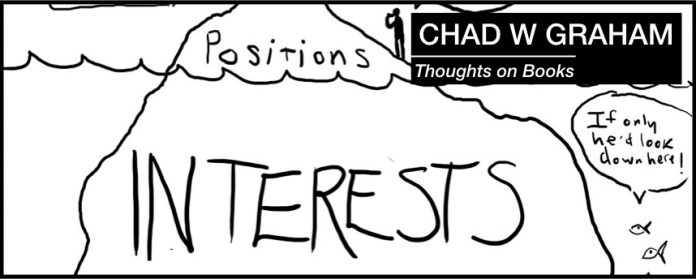Interest-based negotiation is a proposed answer to the critical question, why can’t we just get along? As a parent, I am always petitioning my children to stop fighting, and to get along. But, how can I expect my kids to do this, when most of the adults around them cannot seem do so? The secret to peace between nations and humans is the same—find ways to work together. The trouble is that we just can’t seem to get along.
A cursory reading of Facebook, a few minutes of watching, or reading the news demonstrates our propensity for polarizing conflict. Every day we are reminded that that politics are becoming more and more polarized in Western Democracies (source). The World Economic Forum published a piece arguing that this fragmentation is “crippling Western democracies” (source). Families are not immune. The Independent explains that our societies are experiencing a “family breakdown ‘epidemic’” (source).
A trio of Harvard professors –Fisher, Ury and Patton, in their classic Getting to Yes(now in its 3rdedition: Penguin Books 2011 kindle; .uk.co; .ca) explain that one of the main reasons negotiations in business, family, or politics break down, is that parties get fixated on their positions. People are then left with three choices, win, lose, or compromise.
Now, it’s great to win. But what if winning costs you a friendship? It’s brutal to lose, but what if that is the cost of keeping your job? If you are absolutely convinced you are in the right, how can you accept compromise? But what if the zero-sum approach leads to a total loss?
Why Can’t We Just Get Along: Interest-Based Negotiation
What Fisher, Ury and Patton have done, is changed the rules of the game. In every disagreement that ends up in a negotiation, they explain, there are two aspects. First there is the substantive difference between the parties. Second, there is the process by which the two sides engage. The process is where the problems lie. On social media, and in the mainstream media, and in the alternative medias this process is usually a process of making outrageous ad hominem attacks (an argument or reaction directed against a person rather than the position they are maintaining), which reinforce the side held by the commentor.
But what would happen if you re-envisioned the process? Fisher, Ury and Patton argue for four game changing steps: (1) Separate the people from the problem; (2) focus on interests, not positions; (3) invent multiple options looking for mutual gains, before deciding what to do; and (4) insist that the results be based on some objective standard.
This process of interest-based negotiation has been very successful in the business world, the political world and in family conflicts. Let me begin by breaking down the steps:
Interest-Based Negotiation Step One: Separate People from the Problems
This first point, “responds to the fact that human beings are not computers” the authors explain (p 12). Our emotions, and their emotions often get in the way. Our first step is therefore to find out the real issue(s) that we are in conflict about. Is there something (anything) concrete that we can discuss?
This seems to be the critical first step most of us miss, when we get into a conflict. We are usually upset, or feel threatened, or even overcome by the excitement and opportunity before us. We fail to realize the person who upsets us, threatens us, or stands in our way, probably feels the same way!
Interest-Based Negotiation Step Two: Focus on Interests, Not Positions
This second point is crucial. If we want to move past the thee options of the old way (Win, Lose, or Compromise), we have to do a little careful consideration. What do I really want? Why am I convinced that I need X position to happen/be true? What am I seeking, or defending, or feeling? If I can identify my real interest, rather than my position, I might be able to see other positions, maybe even many positions, which would achieve what I desire. And if I know what the other party wants, well, maybe we can both win!
Interest-Based Negotiation Step Three: Invent Multiple Options Looking for Mutual Gains, Before Deciding What to Do
This third step might just change everything. It recognizes “the difficulty of designing optimal solutions under pressure” (p. 12). I think about final exams when I contemplate this step. You have been in classes for 8 months and read and hear a significant amount of material. Most exams in law school are designed as closed book, 100% finals. So, you show up, and you have 3 hours to find optimal solutions to problem-based questions. I fail to see how this is real world applicable!
But in difference of opinion, in church, politics, family, or business, you have the chance to step back. You have taken the emotion out of the equation by focusing on the problem to be solved, not the person to be attacked. You have discovered what yours, and the other party’s real interests are, now you can brainstorm. This is not a zero-sum game. There are win-win solutions to most conflicts.
The newly discovered solution may not look anything like your original position. But if the thing you are really interested in is satisfied, why would you care?
Interest-Based Negotiation Step Four: Insist on Using Objective Criteria
Interest-based negotiation takes hard work. This is the most time consuming stage (However, you are long past the most difficult is probably the emotional hurdle of step one!). The authors of Getting to Yesexplain the three stages of this step: (1) the analysis stage, (2) the planning stage, (3) the discussion stage.
If you can take your time and gather and organize information, you will be in a position to plan for wise, efficient, and amicable outcomes. Having figured out the problem, discovered each parties interests, and committed to invent multiple solutions, you are finally ready to have that discussion you wanted to short-circuit with a Tweet.






